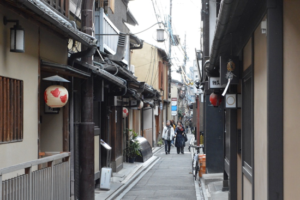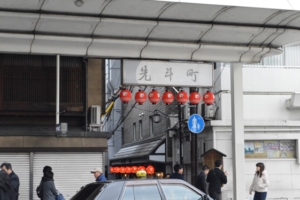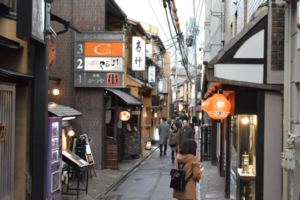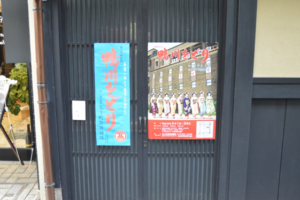The Attraction of the "Kagai Districts” in Kyoto
 camera_alt
Photo maiko’s name is takou
camera_alt
Photo maiko’s name is takou
If you are a man, you will want to go to the Kagai districts in Kyoto.
Far removed from today’s fast paced life, the experience of entering this enchanting nighttime world is fascinating for men of any age. However, in order to enter and take part in the Kyoto Kagai, it is necessary to prepare accordingly. What we call "ochayas" (literally: tea houses), are the entranceways into this world, and their history goes back 300 years to the beginning of the Edo Period.
First, you need to know that there are certain customs and rules to follow at an ochaya. Usually you can’t even get into an ochaya unless you have gotten past the famous "refusal of unfamiliar customers" wall. With rare exceptions, only established patrons may enter an ochaya. Then, after you enter, there are certain rules to observe to truly enjoy your time in an ochaya.
We heard the following from Ms. Junko Ueda who is the 6th generation owner of a well-established ochaya called "Uedaume" in Pontocho.
Ms. Ueda’s life story, from maiko, to geisha, and now proprietor of 'Uedaume'
There are many women who long for the graceful appearance of the maiko and geisha. How did you get into this world?
Ms. Ueda: “My hometown is Onomichi City in Hiroshima. I graduated from junior high school and came to Pontocho because I longed to be a maiko. After an apprenticeship of 10 months, I became a maiko. Then, when I was 21, I changed my collar (graduating from maiko to geisha) and became a geisha. Six years ago, I received an offer of take over as the proprietor of Uedaume, and I have been doing my best to do this job since then.”
Ms. Ueda graduated from junior high school and came up to Kyoto, then became a Geisha after years of tough training as a maiko. For the past 6 years she has been acting as proprietor for Uedaume.
Ms. Ueda: “When I took over the Uedaume, and was learning the in’s and out’s of the business, I stopped having lessons and being a geisha, but I couldn’t bring myself to give up on performing, so I started having lessons again and have been on the stage for the past two years.”
Only in Kyoto are you able to feel the graceful and refined character of Ms. Ueda, such as you would expect of the owner of a teahouse in Kyoto.
The difference between maiko and geisha
Ms Ueda: “Maiko are from 15, or16 years old until 20. In order to become a good geisha, maiko learn the mannerisms of a geisha and practice long and hard. After becoming a geisha, we can remain geisha for life, but we must continually practice and continue to polish our performance. It is such a world.”
According to Ms. Ueda, there are differences, not only in training, but also in appearance between maiko and geisha.
Ms. Ueda: “One difference in appearance is that maiko use their own hair to set; geisha on the other hand, wear wigs. Also, the appearance of maiko is more childlike. They wear a long obi (wide belt), a kimono with middle-length sleeves pleated at the shoulder, and they wear "okobo" (wooden footwear). Geisha sleeves are short, and the obi is tied like a drum and made short.”
Through training, maiko grow to be geisha. Their growth as maiko parallels their human growth into adulthood.
When a maiko becomes a geisha
 Ms Ueda: “We call it "Erigae"; the graduation from being a maiko to becoming a geisha. It is an important event like other traditional public coming of age ceremonies.
Ms Ueda: “We call it "Erigae"; the graduation from being a maiko to becoming a geisha. It is an important event like other traditional public coming of age ceremonies.
After we become geishas, we perform on the same stage with our seniors who have much more experience. For that, we need to practice hard to do our best performance ever.
During our lessons, we learn classical Japanese dance, flute and drums called Ohayashi, hand drums called Tsuzumi, large drums called Okawa, Shamisen, plus songs such as "Nagauta", "Tokiwazu", "Kiyomoto", "Kouta". We also learn tea ceremony and many other subjects. At the beginning of maiko training, we take lessons in the morning, and then get ready to go to the Zashiki room. Maiko are very busy every day, studying hard to some day be an attractive geisha.”
There is a beautiful image in people’s minds when they hear the word “Kagai”. However, considering the difficult training of maiko and geisha, we need to see not only their training rich with history but also their training in hospitality.
Characteristics of a teahouse and the reason for "refusal of unfamiliar customers"
 Now that we understand a little of the background, let’s discuss the characteristics of a tea house.
Now that we understand a little of the background, let’s discuss the characteristics of a tea house.
Ms Ueda: “People call these districts of Kyoto, “Kagai”. In Kyoto there is Gionkoubu, Gion Higashi, Kamishichiken, Miyagawacho, Pontocho and Gokagai.
Each district has its own ochayas which are the places where we offer warm hospitality to the customers. An ochaya basically serves food dishes, and it is always our pleasure to do everything possible to answer a customer’s requests. For example: when the customers are having kaiseki cuisine but they want to change the menu, we sometimes need to order deli or sushi from another restaurant to serve to them. Or when the customers are from another country, we may want to serve more meat in their dishes. If the customer has a small appetite, we order a shoukado lunch box.
When customers are leaving, it is our delight to hear them say; "It was delicious today! I had a great time!"
Ochayas don't have fixed menus, but serve food according to the customers wishes. It’s hard to believe it is like that. We can say this is the best part of an ochaya.
Ms Ueda: “I offer a warm atmosphere of hospitality to make the ochaya like a "second home" for our patrons. I believe that it is possible to do so only by having a relationship of trust with our customers. That is the reason why ochayas usually refuse first time visitors. No one would let a person they don't know into their house, would they?”
Ms. Ueda says that she shows this warm hospitality to all customers.
Ms Ueda: “My aim is to have an ochaya, where the patrons come in and feel, "I'm home", and we daily continue to work toward that end.”
The foundation is a basic connection between people
 In this way, ochayas offer a relationship with their customer that is akin to a friendship or a close acquaintance. What lies behind the running of an ochaya is the fundamental connection between people.
In this way, ochayas offer a relationship with their customer that is akin to a friendship or a close acquaintance. What lies behind the running of an ochaya is the fundamental connection between people.
Ms Ueda: “Even if they first visited us by being introduced by a patron, some of them are now very faithful customers, and we continue to strive to have more of such faithful customers.”
Being supported by such a rich heritage and tradition is a rare honor for the owner of an ochaya. It is also a reflection to the lasting culture of the Kagai.
Ms Ueda: “An ochaya can’t give the guests that warm hospitality, unless the ochaya, geisha and maiko work together. This relationship is very important.
Some of the customers have continued to come here for over a generation, and we take great effort to make sure those guests leave satisfied. We also do our best to make new customers feel like coming back again and again.”
Enjoying historical events of the Kagai
 I heard that there is an event recommended for those who want to enjoy, not only an ochaya, but also the entertainment itself. The first one is the "Pontocho Kamogawa Odori"
I heard that there is an event recommended for those who want to enjoy, not only an ochaya, but also the entertainment itself. The first one is the "Pontocho Kamogawa Odori"
Ms. Ueda: “Held since 1872, one of the annual events is "Pontocho Kamogawa Odori". We are grateful that, this year, we will be able to hold our 180th festival. It will be held from May 1st to May 24th, with 3 daily performances. I will be appearing as well. I would very much like you to come and see.”
‘A classical Japanese dance boasting the most performances at Kagai in Kyoto ‘
The first public performance of "Kamogawa Odori" was held in 1872, as a traditional spring dance festival by one of the Gokagai in Kyoto.
The festival was suspended during the early Meiji period and also during the Second World War, but was started again immediately after the war ended and continues to this day. Between 1951 and 1998, performances were held twice a year, in the spring and autumn. As of 2015, "Kamogawa Odori" has been performed 178 times, and boasts the highest number of performances among Gokagai in Kyoto.
The "Kamogawa Odori" is now performed only in the spring, entertaining audiences with dance performances: a dance drama (part 1), and a classical dance (part 2) by gorgeous maiko. Their charm has made quite a reputation abroad and has attracted overseas celebrities such as Jean Cocteau and Charlie Chaplin.
Since the early Showa period, some western music has been used in the Kamogawa dance. The girls’ revue (musical) not only seeks to keep with tradition, but is also constantly evolving and seeking new ideas. (quote from HP)
The second festival is “Suimeikai”.
Ms. Ueda: “There is also another yearly event called "Suimeikai". It is a four day dance festival. “Suimeikai” is also a traditional event in Pontocho similiar to the “Kamogawa Odori”. We look forward to your visit.”
"Suimeikai" is one of the representative events of Pontocho. It was first performed on March 15th, 1930 by the merging of two artist study groups: the "Nagautachiyoeikai", established in 1907; and the "Doyoukai", established in September, 1927. "Suimeikai" is named after the clear stream of the Kamogawa River.
The original performances consisted only of geisha with a high level of training.
Up until the 36th performance in October, 1941, they continued to perform three times a year: in March, June and October. Back then people could buy a "yearly ticket" which enabled them to watch performances throughout the year with one ticket. In 1941 “Suimeikai” was cancelled indefinitely.
After the Second World War, "Suimeikai" was revived, and from September 1949 until 1953, people were able to watch the performances twice a year; in March and September. After 1953, performances have been held in March for only one day, with day and evening performances on the same day. In 1999, when the yearly autumn “Kamogawa Odori” was dropped, “Suimeikai” was changed from March to October. (quote from HP)
In this article, you get a small glimpse into the charm of the Kagai and ochayas of Kyoto. To feel the real essence of these performances, and the amount of effort and time that goes into this form of entertainment, why don't you come to Pontocho to see the performance live.
〈Interview cooperation〉
Ponto-cho website
<Reference>
"About rules of the Ochaya"
"Rules of play & a list of traditional Japanese restaurants.
Let's play Ozashiki-Asobi in Kyoto! "










